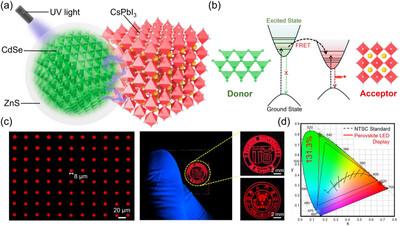Förster Resonance Energy Transfer-Based Design of High-Brightness CdSe/ZnS-CsPb(BrI)3 Nanocrystals for High-Performance Micro-LED Color Conversion Pixels
IF 10
1区 物理与天体物理
Q1 OPTICS
引用次数: 0
Abstract
Poor performance of red-emitting all-inorganic CsPbX3 (X = Cl, Br, I) perovskite nanocrystals, specifically their low excitation efficiency in the blue and Ultraviolet A spectral ranges, limits their application as color conversion layers for micro-LED displays. In this work, new nanocomposites featuring CdSe/ZnS-CsPb(BrI)3 heterostructure nanocrystals (hs-NCs) are develpoed, where the built-in Förster resonance energy transfer mechanism enhances red emission by efficiently transferring excitation energy from CdSe/ZnS to CsPb(BrI)3. Consequently, the photoluminescence excitation spectrum of hs-NCs shifts to peak in the Ultraviolet A range, achieving a nearly highest photoluminescence quantum yield of 98.7% under 400 nm excitation. The hs-NCs demonstrate high compatibility with ultra-fine electrohydrodynamic inkjet printing, enabling fabrication of high-resolution, bright, and stable pure-red CCL arrays with a minimum pixel size of 8 µm. When combined with blue and green perovskite nanocrystals, these arrays achieve full-color pixel configurations with a color gamut of 131.3% NTSC standard. These results offer a substantial breakthrough on the quality of color conversion layers while opening new avenues for the advancement of micro-LED display technologies.

Förster基于共振能量转移的高亮度CdSe/ZnS-CsPb(BrI)3纳米晶体高性能微型led颜色转换像素设计
发射红光的全无机CsPbX3 (X = Cl, Br, I)钙钛矿纳米晶体性能不佳,特别是在蓝光和紫外光A光谱范围内激发效率低,限制了其作为微型led显示屏颜色转换层的应用。在这项工作中,开发了具有CdSe/ZnS-CsPb(BrI)3异质结构纳米晶体(hs- nc)的新型纳米复合材料,其中内置的Förster共振能量转移机制通过有效地将激发能从CdSe/ZnS转移到CsPb(BrI)3来增强红色发射。因此,hs-NCs的光致发光激发光谱在紫外A范围内达到峰值,在400 nm激发下实现了98.7%的最高光致发光量子产率。hs- nc与超细电流体动力喷墨打印具有很高的兼容性,可以制造高分辨率,明亮,稳定的纯红色CCL阵列,最小像素尺寸为8µm。当与蓝色和绿色钙钛矿纳米晶体结合时,这些阵列实现了全彩色像素配置,色域为131.3% NTSC标准。这些结果在颜色转换层的质量方面提供了实质性的突破,同时为微型led显示技术的发展开辟了新的途径。
本文章由计算机程序翻译,如有差异,请以英文原文为准。
求助全文
约1分钟内获得全文
求助全文
来源期刊
CiteScore
14.20
自引率
5.50%
发文量
314
审稿时长
2 months
期刊介绍:
Laser & Photonics Reviews is a reputable journal that publishes high-quality Reviews, original Research Articles, and Perspectives in the field of photonics and optics. It covers both theoretical and experimental aspects, including recent groundbreaking research, specific advancements, and innovative applications.
As evidence of its impact and recognition, Laser & Photonics Reviews boasts a remarkable 2022 Impact Factor of 11.0, according to the Journal Citation Reports from Clarivate Analytics (2023). Moreover, it holds impressive rankings in the InCites Journal Citation Reports: in 2021, it was ranked 6th out of 101 in the field of Optics, 15th out of 161 in Applied Physics, and 12th out of 69 in Condensed Matter Physics.
The journal uses the ISSN numbers 1863-8880 for print and 1863-8899 for online publications.

 求助内容:
求助内容: 应助结果提醒方式:
应助结果提醒方式:


